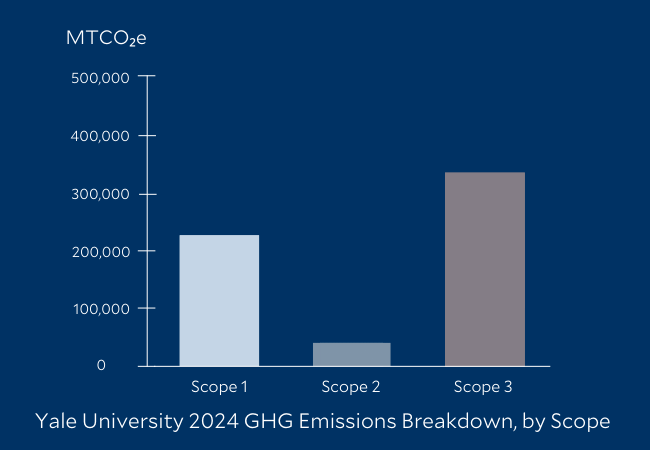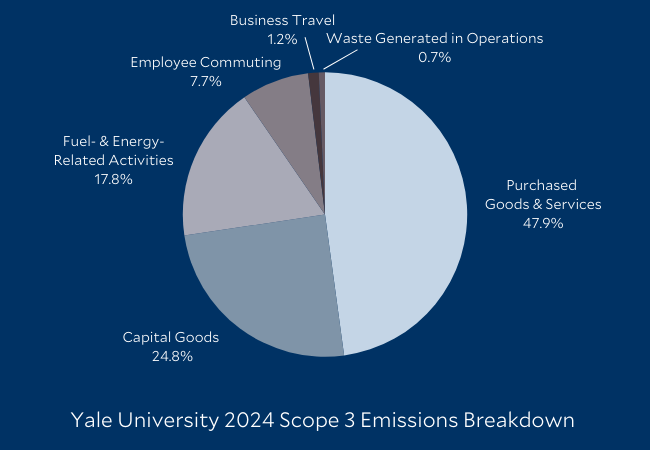Yale is committed to achieving zero actual carbon emissions by 2050 with an interim goal to reach net zero emissions by 2035. This goal extends across scope 1 emissions (direct emissions from sources owned or controlled by Yale, including emissions from our fleet of vehicles and our power plants) and scope 2 emissions (indirect emissions from purchased electricity), but not scope 3 emissions. Scope 3 emissions are indirect emissions that occur because of Yale’s operations, but from sources not owned or controlled by the University.
Scope 3 emissions categories include:
- purchased goods and services
- capital goods
- fuel- and energy-related activities
- transportation and distribution
- waste generated in operations
- business travel
- employee commuting
- leased assets
- processing of sold products
- use of sold products
- end of life treatment of sold products
- franchises
- investments
Data for scope 3 emissions can be difficult to obtain, so quantifying scope 3 emissions is not as straightforward as it can be for scopes 1 and 2. We are working hard to gather the best information possible about scope 3 emissions to begin addressing this significant part of our campus footprint.
One of the goals in the Yale Sustainability Plan 2025 is to account for the impacts associated with scope 3 emissions. In 2017, we began a close analysis of our scope 3 emissions by looking at the various categories we might track. We identified these areas as relevant to Yale’s operations:
- purchased goods & services
- capital goods
- fuel- and energy-related activities (FERA)
- waste generated in operations
- business travel
- employee commuting
- student travel (a category that we created in order to capture a set of emissions specific to educational institutions)
Tracking most of these categories began in 2018, though we started assessing availability of student travel data in 2021. We explored the possibility of tracking emissions associated with Yale’s investments, but lack sufficient data to do so.
How is our scope 3 data collected and measured?
Yale follows the World Resource Institute’s Scope 3 Calculation Guidance. Emissions factors are reviewed and updated annually.
- Emissions associated with purchased goods and services and capital goods are based on purchasing data and commodity type.
- Fuel- and energy-related activities create emissions through extraction and transportation of natural gas to Yale. Data comes from our scope 1 and 2 records.
- Emissions from waste generated in operations (recycling, waste-to-energy processing, and anaerobic digesting) are calculated using waste tonnage.
- Business travel emissions come from two sources: data from the university’s travel booking tool, and travel reimbursement data. Travel reimbursement data is removed from the purchased goods and services data set to avoid double counting.
- Employee commuting data is gathered from the university’s bi-annual transportation survey.
- We are currently exploring availability of data associated with student travel across Yale College and our graduate and professional schools.
By the numbers


Scope 3 Collaboration
Sustainability and procurement staff from Harvard, MIT, Stanford, and Yale convened a small ad hoc working group to identify a shorter list of Scope 3 emissions Purchased Goods & Services (PGS) and Capital Goods subcategories particularly relevant to higher education. First, we compared our institutions’ top 100 highest spend categories. Next, we defined “actionability” criteria and excluded the “least actionable” categories. Finally, we leveraged our offices’ past Scope 3 heatmapping and materiality exercises to identify likely hot spots (high emissions). The resulting shortlist includes areas that are likely to be both actionable and emissions hot spots. We hope this work can enable other research universities to leapfrog the initial PGS discovery stage and serve as a foundation for prioritization. Read the full paper here.